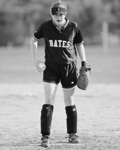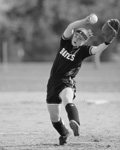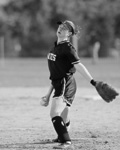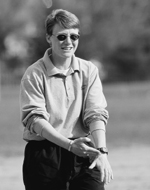Sports Notes
Super K and the rest — Bates softball coach Gwen Lexow untangles the “other” pitching motion



The fraction of a second when a human athlete explodes with kinetic power is familiar to even the casual sports fan. Decades of sports photography have etched in our minds such moments: the image of Chris Evert connecting with a two-fisted backhand, Manny Ramirez sending a hanging curve toward the Southeast Expressway, or even grimacing Al Oerter heaving the shot put.
Perhaps less familiar is the windmill motion of the softball pitcher. It’s the underhand cousin of the shoulder-wrenching baseball motion. Yet, as seen here in photos taken by Phyllis Graber Jensen last spring, the motion is as athletically explosive and just as poetic as, say, a Tiger Woods swing.
“The softball motion is all about rhythm and timing,” says Bates softball coach Gwen Lexow, who led the Bobcats to a 18-13 record last spring. The team won 11 of its last 12 games and set a Bates record for wins. “If you have excellent rhythm and timing, you’re going to be an excellent softball pitcher.”

Helpful too, says Lexow, is a pitcher with “long levers,” long arms and legs like a Randy Johnson — or like 5-foot, 8-inch Bates pitcher Ginger Walsh ’03 of Hopkinton, N.H., seen here.
A softball pitcher takes a stance with both feet on the rubber, facing the catcher. She steps back with the left foot (similar to a baseball pitcher). But instead of then lifting and curling the left leg as in a baseball motion, the softball pitcher points the left leg toward the catcher while shifting weight to the right leg. Her right arm windmills up and around to a 1 o’clock position, with the left arm at 10 o’clock, in a spread eagle Lexow calls the “ta-da!” or “super K” position. Hips, torso, and chest face third base. All weight is loaded onto the right leg.
Then comes the blinding, synchronized transfer of energy. The pitching arm windmills around in a relaxed, whipping motion. The pitcher drives her weight onto the firm left leg, now planted on the ground (photo 5 and at right). The hips thrust toward the plate. “Like Elvis,” says Lexow. The final motion, as the arm reaches the bottom of its arc, is a wrist snap that imparts a variety of spins on the ball. The 6.5-oz. ball, an ounce heavier than a baseball, flies 43 feet toward the batter at about 60 mph for Bates pitchers, 70 mph for world’s best pitchers. The softball arrives at home plate as quickly as a 100-mph ball gets to a hitter in baseball.
Compared to the overhand baseball motion, which tends to shred the shoulder and elbow over time, the underhand motion is easy on the shoulder and arm. The best collegiate pitchers often pitch every one of their team’s games. “You’ll see a baseball pitcher ice their shoulder. A softball pitcher will usually ice her forearm, because that’s where the fatigue is from the wrist flip,” said Lexow.